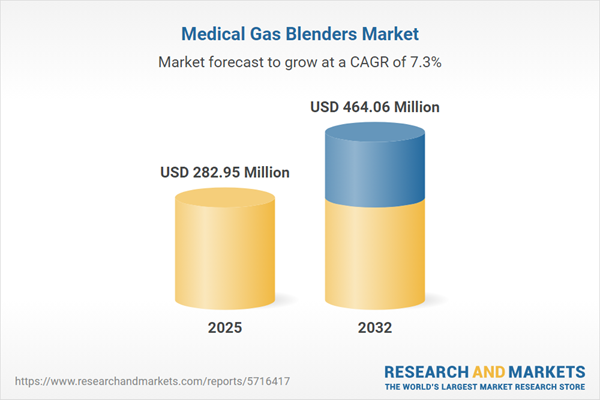Speak directly to the analyst to clarify any post sales queries you may have.
The medical gas blenders market is evolving rapidly, fueled by rising demand for precise gas delivery and advanced patient safety standards. As healthcare workflows become more sophisticated, the sector presents fresh opportunities and challenges for industry stakeholders focused on operational efficiency, technological integration, and regulatory compliance.
Market Snapshot: Medical Gas Blenders Market Growth and Outlook
The Medical Gas Blenders Market grew from USD 263.19 million in 2024 to USD 282.95 million in 2025. It is projected to maintain robust momentum, expanding at a CAGR of 7.34% and reaching USD 464.06 million by 2032. This upward trajectory is driven by heightened demand for devices that ensure precision and reliability across clinical environments.
Scope & Segmentation
This report delivers a detailed analysis of the medical gas blenders market, focusing on key segments across product functionality, end user profiles, application contexts, gas types, and regional markets. The coverage includes:
- Product Type: Analog continuous flow, digital continuous flow, adjustable ratio proportional, and fixed ratio proportional devices.
- End User: Ambulatory surgical centers (hospital affiliated and standalone), clinics (multispecialty and pulmonary), and hospitals (government and private).
- Application: General anesthesia, regional anesthesia, neonatal use (invasive and noninvasive ventilation), and respiratory therapy for adults and pediatrics.
- Gas Type: O2 Air (adjustable and fixed ratio) and O2 N2O (adjustable and fixed ratio) configurations.
- Regions: Americas (North America and Latin America), Europe, Middle East & Africa (with subregional distinctions), and Asia-Pacific (including developed and emerging economies).
- Technology Focus: Digital flow control systems, fail-safe alarms, IoT connectivity, real-time analytics, and integration with hospital information systems.
Key Takeaways for Senior Decision-Makers
- The trend toward digitalization is transforming device performance, enabling clinicians to achieve higher precision and reducing manual intervention in gas delivery.
- Compliance with evolving medical device directives and risk management protocols is shaping R&D cycles and influencing supplier selection.
- IoT-enabled blenders deliver remote monitoring and predictive maintenance benefits, supporting proactive asset management and optimized availability.
- Strategic localization in manufacturing is strengthening supply chain resilience and mitigating exposure to international logistics costs.
- Strong collaborative relationships between manufacturers and clinical end users are facilitating rapid adoption of customized solutions that enhance productivity and patient safety.
- Regional markets present distinct adoption curves, with premium digital systems gaining traction in established economies, while reliable analog solutions remain preferred in cost-sensitive and emerging regions.
Tariff Impact: Effects of US 2025 Tariff Measures on Supply Chain
Recent tariff policy changes in the United States have increased the cost of key components and finished assemblies for gas blenders. These regulatory shifts are driving manufacturers to reconsider procurement strategies, emphasizing local sourcing and regional hub investment to preserve margin and responsiveness. Procurement teams are also renegotiating contracts and adopting new frameworks to buffer against price fluctuations while maintaining quality standards.
Methodology & Data Sources
Research was anchored by a blend of quantitative modeling—covering shipment data, expenditure patterns, and supply chain cost trends—and qualitative interviews with clinical, engineering, and procurement stakeholders. Validation involved triangulation with proprietary and secondary datasets, and rigorous review processes ensured alignment with current industry standards and best practices.
Why This Report Matters
- Enables data-driven, strategic investment by presenting actionable insights on technology, supply chains, and regulatory frameworks relevant to the medical gas blenders market.
- Equips decision-makers with a clear understanding of market segmentation, enabling tailored product positioning and market entry or expansion strategies.
- Provides critical competitive intelligence to support planning, risk management, and stakeholder alignment across diverse healthcare settings.
Conclusion
The medical gas blenders market is shaped by ongoing innovation, regulatory demands, and supply chain adaptation. Senior leaders who prioritize integration, agility, and stakeholder engagement will position their organizations for long-term value and sustained sector leadership.
Additional Product Information:
- Purchase of this report includes 1 year online access with quarterly updates.
- This report can be updated on request. Please contact our Customer Experience team using the Ask a Question widget on our website.
Table of Contents
3. Executive Summary
4. Market Overview
7. Cumulative Impact of Artificial Intelligence 2025
Companies Mentioned
The companies profiled in this Medical Gas Blenders market report include:- Air Liquide S.A.
- Linde plc
- Air Products and Chemicals, Inc.
- Taiyo Nippon Sanso Corporation
- SIAD S.p.A.
- Inox Air Products Limited
- Chart Industries, Inc.
- Parker-Hannifin Corporation
- Matheson Tri-Gas, Inc.
- Everflow Engineering Pvt. Ltd.
Table Information
| Report Attribute | Details |
|---|---|
| No. of Pages | 194 |
| Published | November 2025 |
| Forecast Period | 2025 - 2032 |
| Estimated Market Value ( USD | $ 282.95 Million |
| Forecasted Market Value ( USD | $ 464.06 Million |
| Compound Annual Growth Rate | 7.3% |
| Regions Covered | Global |
| No. of Companies Mentioned | 11 |









